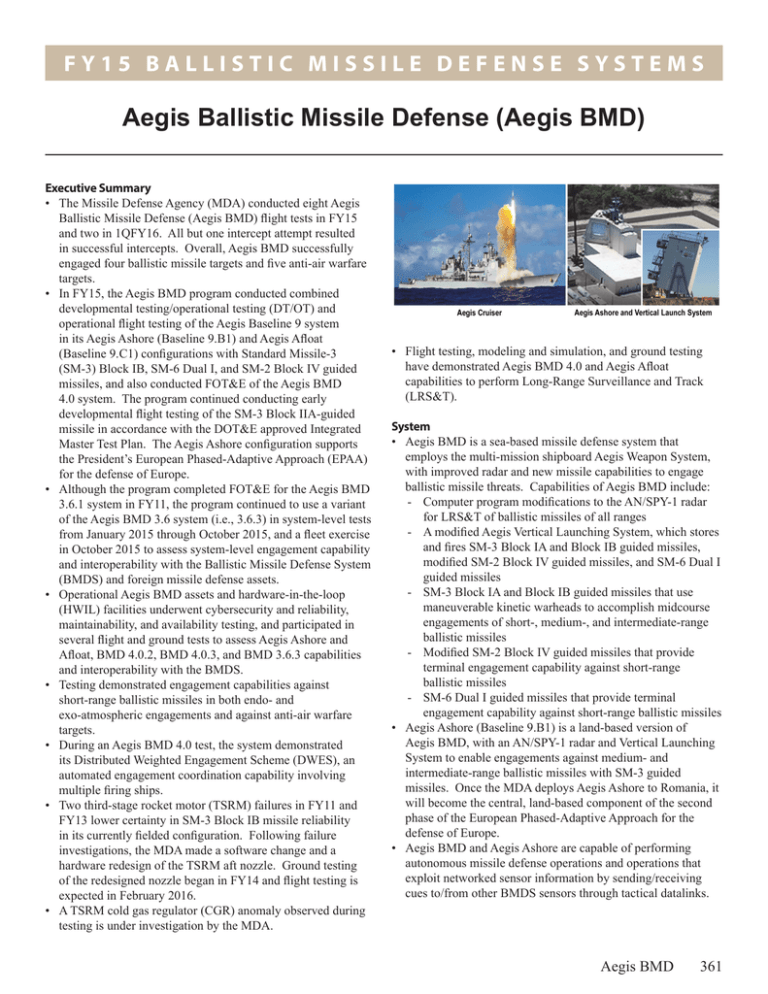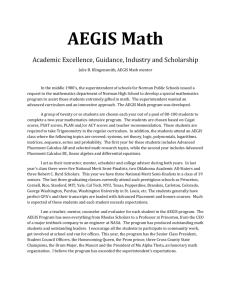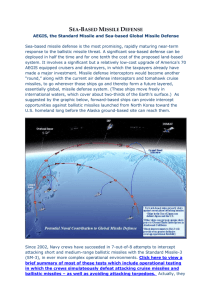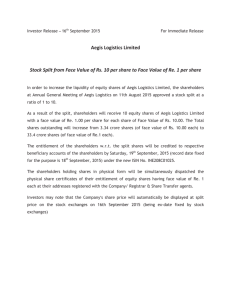F Y 1 5 B A L L...
advertisement

FY15 BALLISTIC MISSILE DEFENSE SYSTEMS Aegis Ballistic Missile Defense (Aegis BMD) Executive Summary • The Missile Defense Agency (MDA) conducted eight Aegis Ballistic Missile Defense (Aegis BMD) flight tests in FY15 and two in 1QFY16. All but one intercept attempt resulted in successful intercepts. Overall, Aegis BMD successfully engaged four ballistic missile targets and five anti-air warfare targets. • In FY15, the Aegis BMD program conducted combined developmental testing/operational testing (DT/OT) and operational flight testing of the Aegis Baseline 9 system in its Aegis Ashore (Baseline 9.B1) and Aegis Afloat (Baseline 9.C1) configurations with Standard Missile-3 (SM-3) Block IB, SM-6 Dual I, and SM-2 Block IV guided missiles, and also conducted FOT&E of the Aegis BMD 4.0 system. The program continued conducting early developmental flight testing of the SM-3 Block IIA-guided missile in accordance with the DOT&E approved Integrated Master Test Plan. The Aegis Ashore configuration supports the President’s European Phased-Adaptive Approach (EPAA) for the defense of Europe. • Although the program completed FOT&E for the Aegis BMD 3.6.1 system in FY11, the program continued to use a variant of the Aegis BMD 3.6 system (i.e., 3.6.3) in system-level tests from January 2015 through October 2015, and a fleet exercise in October 2015 to assess system-level engagement capability and interoperability with the Ballistic Missile Defense System (BMDS) and foreign missile defense assets. • Operational Aegis BMD assets and hardware-in-the-loop (HWIL) facilities underwent cybersecurity and reliability, maintainability, and availability testing, and participated in several flight and ground tests to assess Aegis Ashore and Afloat, BMD 4.0.2, BMD 4.0.3, and BMD 3.6.3 capabilities and interoperability with the BMDS. • Testing demonstrated engagement capabilities against short‑range ballistic missiles in both endo- and exo‑atmospheric engagements and against anti-air warfare targets. • During an Aegis BMD 4.0 test, the system demonstrated its Distributed Weighted Engagement Scheme (DWES), an automated engagement coordination capability involving multiple firing ships. • Two third-stage rocket motor (TSRM) failures in FY11 and FY13 lower certainty in SM-3 Block IB missile reliability in its currently fielded configuration. Following failure investigations, the MDA made a software change and a hardware redesign of the TSRM aft nozzle. Ground testing of the redesigned nozzle began in FY14 and flight testing is expected in February 2016. • A TSRM cold gas regulator (CGR) anomaly observed during testing is under investigation by the MDA. • Flight testing, modeling and simulation, and ground testing have demonstrated Aegis BMD 4.0 and Aegis Afloat capabilities to perform Long-Range Surveillance and Track (LRS&T). System • Aegis BMD is a sea-based missile defense system that employs the multi-mission shipboard Aegis Weapon System, with improved radar and new missile capabilities to engage ballistic missile threats. Capabilities of Aegis BMD include: - Computer program modifications to the AN/SPY-1 radar for LRS&T of ballistic missiles of all ranges - A modified Aegis Vertical Launching System, which stores and fires SM-3 Block IA and Block IB guided missiles, modified SM-2 Block IV guided missiles, and SM-6 Dual I guided missiles - SM-3 Block IA and Block IB guided missiles that use maneuverable kinetic warheads to accomplish midcourse engagements of short-, medium-, and intermediate-range ballistic missiles - Modified SM-2 Block IV guided missiles that provide terminal engagement capability against short-range ballistic missiles - SM-6 Dual I guided missiles that provide terminal engagement capability against short-range ballistic missiles • Aegis Ashore (Baseline 9.B1) is a land-based version of Aegis BMD, with an AN/SPY-1 radar and Vertical Launching System to enable engagements against medium- and intermediate-range ballistic missiles with SM-3 guided missiles. Once the MDA deploys Aegis Ashore to Romania, it will become the central, land-based component of the second phase of the European Phased-Adaptive Approach for the defense of Europe. • Aegis BMD and Aegis Ashore are capable of performing autonomous missile defense operations and operations that exploit networked sensor information by sending/receiving cues to/from other BMDS sensors through tactical datalinks. Aegis BMD 361 FY15 BALLISTIC MISSILE DEFENSE SYSTEMS Mission The Navy can accomplish three missile defense-related missions using Aegis BMD: • Defend deployed forces and allies from short- to intermediate‑range theater ballistic missile threats • Provide forward-deployed radar capabilities to enhance defense against ballistic missile threats of all ranges by sending cues or target track data to other elements of the BMDS • Provide all short- to long-range ballistic missile threat data to the Command and Control, Battle Management, and Communications (C2BMC) system for dissemination to Activity • From November 2014 through October 2015, the MDA conducted combined DT/OT and operational flight testing of the Aegis Baseline 9 system in its Aegis Ashore and Afloat configurations with SM-3 Block IB guided missiles, and conducted FOT&E of the Aegis BMD 4.0 system. Additionally, in June 2015, the MDA conducted early developmental flight testing of the SM-3 Block IIA guided missile. • Although the program completed FOT&E for the Aegis BMD 3.6.1 system in FY11, the program continued to use a variant of the Aegis BMD 3.6 system (i.e., 3.6.3) in system-level tests and a fleet exercise in 1QFY16 to assess system-level engagement capability and interoperability with the BMDS and foreign missile defense assets. • The Aegis BMD program planned to conduct nine flight tests in FY15, but only completed eight. The program also conducted two intercept missions in 1QFY16. Aegis BMD successfully engaged four ballistic missile targets and five anti‑air warfare targets. - In November 2014, the MDA conducted Flight Test Standard Missile-25 (FTM-25), an Integrated Air and Missile Defense mission where an Aegis BMD 5.0 with Capability Upgrade destroyer, operating in Integrated Air and Missile Defense priority mode, detected, tracked, and performed an SM-3 Block IB intercept of a separating short-range ballistic missile, while simultaneously conducting an anti-air warfare raid engagement against a raid of two subsonic cruise missile surrogates. - The BMDS Operational Test Agency and the MDA attempted Flight Test Operational-02 (FTO-02) Event 1 in June 2015, at the Pacific Missile Range Facility on Kauai, Hawaii. The BMDS Operational Test Agency and MDA intended to demonstrate the operational capability of the regional/theater EPAA Phase 2 BMDS, anchored by the Aegis Ashore combat system, to defend Europe against medium-range ballistic missiles. The test was intended to be the first target intercept by the Aegis Ashore combat system and the first flight test of the SM-3 Block IB Threat Update guided missile. Due to a target malfunction, the 362 Aegis BMD Combatant Commanders’ headquarters to ensure situational awareness Major Contractors • Aegis BMD Weapon System: Lockheed Martin Corporation, Mission Systems and Training – Moorestown, New Jersey • AN/SPY-1 Radar: Lockheed Martin Corporation, Mission Systems and Training – Moorestown, New Jersey • SM-3 and SM-6 Missile: Raytheon Company, Missile Systems – Tucson, Arizona test was not completed and the SM-3 guided missile was not launched. This test is scheduled to be attempted again in December 2015. - In a four-event Multi-Mission Warfare (MMW) test campaign in July 2015, an Aegis BMD 5.0 with Capability Upgrade destroyer detected, tracked, and engaged cruise missile and short-range ballistic missile targets. In MMW Event 1, the ship intercepted a short-range ballistic missile in the endo-atmosphere with an SM-6 Dual I missile. This was the first intercept of a ballistic missile using an SM-6 Dual I using the Baseline 9 sea-based terminal capability. In MMW Event 2, the ship intercepted a short-range ballistic missile target with an SM-2 Block IV missile, demonstrating retention of Aegis BMD 3.6.1 near-term sea-based terminal capability. Events 3 and 4 of the MMW campaign included SM-6 Dual I missile engagements of anti-ship cruise missile surrogates to demonstrate retention of air defense capability with the SM-6 Dual I missile. - At-Sea Demonstration-15 in October 2015 was a multi‑event fleet exercise wherein assets from North Atlantic Treaty Organization member countries explored the exchange of air and ballistic missile message information across operational communication architectures during cruise missile and ballistic missile engagements. One of the nine events in the exercise included an engagement of a short-range non-separating ballistic missile by an Aegis BMD 3.6.3 destroyer with an SM-3 Block IA guided missile. In the live fire engagement, the ship detected, tracked, and intercepted the ballistic missile target. Participating assets also included an Aegis BMD 3.6.3 laboratory representation, an Aegis 5.3.10 air defense ship, C2BMC, and allied naval vessels from Great Britain, Spain, Netherlands, Italy, Canada, France, and Norway. - The BMDS Operational Test Agency and the MDA conducted FTO-02 Event 2 and Event 2a in September and October 2015 at Wake Island and the broad-ocean area surrounding it. The MDA designed the test mission to demonstrate a layered BMDS with multiple combat FY15 BALLISTIC MISSILE DEFENSE SYSTEMS systems sharing common defended areas and shot opportunities against two threat-representative ballistic missiles. The primary test objective was to assess Aegis BMD system capability to prosecute a ballistic missile threat engagement in the presence of non-organic post‑intercept debris, while simultaneously conducting anti-air warfare against an air-breathing target. The Terminal High-Altitude Area Defense (THAAD) combat system generated the non-organic post-intercept debris scene for Aegis BMD. • Aegis BMD participated in other live-target or live-interceptor test events in FY15. - In Flight Test Other-20 (FTX-20) in October 2014, the MDA used an Aegis BMD 5.0 with Capability Upgrade destroyer to conduct a simulated SM-3 Block IB engagement of a separating medium-range ballistic missile. Although no live or simulated missiles were fired at the target, the system did exercise several fire control, discrimination, and engagement functions. - In FTX-19 in February 2015, two Aegis BMD 4.0.2 destroyers detected, tracked, and conducted simulated SM-3 Block IB engagements against three short-range separating ballistic missile targets in a raid scenario. This was the first simulated engagement of a raid of three separating targets with the Aegis BMD 4.0 system and the first live-target mission involving Aegis BMD DWES, which provides automated engagement coordination between multiple firing ships. Additionally, an Aegis BMD 5.0 with Capability Upgrade destroyer participated in the test to explore the capability of that system to perform air and ballistic missile defense against a raid of ballistic missiles and a simulated raid of supersonic sea-skimming anti-ship cruise missiles using simulated guided missiles while operating in Integrated Air and Missile Defense priority mode with remote engagement authorized. - In June 2015, the SM-3 Block IIA Cooperative Development Control Test Vehicle-01 (SCD CTV-01) flight test demonstrated SM-3 Block IIA flight through nosecone deployment and TSRM flight. This was the first live fire event for the SM-3 Block IIA guided missile, which is a joint U.S.-Japanese development of a 21-inch diameter variant of the SM-3. This test was the third in a series of six test events to validate missile and canister designs for the Block IIA guided missile. • In FY15, operational Aegis BMD assets and HWIL facilities underwent cybersecurity and reliability, maintainability, and availability testing, and participated in several flight and ground tests to assess Aegis Ashore and Afloat, BMD 4.0, and/or BMD 3.6.3 capabilities and interoperability with the BMDS. - In January 2015, Ground Test Distributed-04e (GTD-04e) Part 2, the MDA tested the engagement and sensor capabilities of fielded and to-be-fielded missile defense elements and sensors against ballistic missiles of all ranges in a distributed environment. Participants included Aegis BMD 4.0.2 and 3.6.3 (laboratory site with sailors from - - - - - the USS Lake Erie, USS Decatur, and USS Hopper on console), C2BMC, Patriot, THAAD, Space-Based Infrared System (SBIRS), AN/TPY-2 (Forward-Based Mode (FBM)), Ground-Based Midcourse Defense (GMD), and Upgraded Early Warning Radars. During Ground Test Integrated-06 (GTI-06) Part 1 in April and May 2015, the MDA tested the engagement and sensor capabilities of fielded and to-be-fielded missile defense elements and sensors against ballistic missiles of all ranges in an HWIL environment. A key focus of the test was the demonstration of the new Aegis Ashore and Afloat capabilities within a realistic BMDS architecture, including engagement coordination with and without the Aegis DWES capability. Participants included HWIL representations of Aegis Ashore and Afloat assets, Aegis BMD 4.0.2 and 3.6.3 (laboratory site with sailors from the Aegis Ashore Missile Defense Facility in Romania, USS Arleigh Burke, and USS Lake Erie on console), C2BMC, Patriot, THAAD, SBIRS, and AN/TPY-2 (FBM). In GTI-06 Part 3 in July 2015, the MDA utilized a test architecture with HWIL representations to evaluate interoperability between Aegis BMD variants and GMD, and interoperability between GMD and other strategic assets. Assets included Aegis BMD 4.0.3, Aegis Afloat, C2BMC, SBIRS, AN/TPY-2 (FBM), and the Sea-Based X-band Radar that was represented but not operational. The Commander, Operational Test and Evaluation Force conducted a cybersecurity Cooperative Vulnerability and Penetration Assessment of Aegis Ashore in August 2015 at the Aegis Ashore Missile Defense Facility in Romania. The MDA also planned to conduct an Adversarial Assessment following the Cooperative Vulnerability and Penetration Assessment; however, the MDA postponed this testing due to incomplete construction and system integration at the Aegis Ashore Site. The Aegis Ashore Missile Defense Test Complex at Pacific Missile Range Facility underwent a maintenance demonstration in September 2015. In GTD-06 Part 1 in October 2015 utilized a distributed test environment to demonstrate Aegis Ashore in Romania, Aegis Afloat, and AN/TPY-2 (FBM) capabilities within a realistic BMDS architecture. Other BMDS assets supporting the test included C2BMC, SBIRS, Upgraded Early Warning Radar, Patriot, THAAD, and laboratory representations of Aegis BMD 4.0.3 and Aegis BMD 3.6.3. Assessment • In FY15 and 1QFY16, the Aegis Afloat system underwent DT/OT and operational flight testing of that system’s exo-atmospheric engagement capabilities (during FTX-20, FTM-25, and FTO-02 Event 2a) and its endo-atmospheric engagement capabilities with SM-6 Dual I and SM-2 Block IV missiles (during MMW Events 1 and 2). Testing demonstrated engagement capabilities against short-range ballistic missiles in both exo- and endo-atmospheric engagements. Additional flight testing and high-fidelity modeling and simulation Aegis BMD 363 FY15 BALLISTIC MISSILE DEFENSE SYSTEMS • • • • • analyses are needed to quantitatively evaluate the effectiveness of the Baseline 9 system at engaging ballistic missiles in the exo- and endo-atmospheric phases of flight for a range of scenarios. FTM-25 demonstrated the use of Integrated Air and Missile Defense radar priority mode in a live engagement during which cruise missile and ballistic missile targets were simultaneously engaged, although only for a less-than-fully stressing case, with a single ballistic missile and a raid of two subsonic cruise missile targets. Three of the MMW events (Events 1, 3, and 4) demonstrated that SM-6 Dual I missiles can be used to conduct sea-based terminal engagements against short-range non-separating ballistic missiles, and that they retain the air defense capabilities that were demonstrated during SM-6 IOT&E and FOT&E flight testing. The MDA intended FTO-02 Event 2 and Event 2a to demonstrate the Aegis Afloat capability to prosecute a ballistic missile threat engagement as part of a layered BMDS in the presence of non-organic post intercept debris, while simultaneously conducting an anti-air warfare engagement in Integrated Air and Missile Defense priority mode. However, shortly following launch, the SM-3 Block IB Threat Update guided missile targeting the medium-range ballistic missile target failed. Prior to this, a THAAD interceptor intercepted the short-range ballistic missile target, generating debris that may enable accurate modeling and simulation of Aegis BMD combat system capability in the presence of post intercept debris. At the same time Aegis BMD was attempting to engage the ballistic missile target with the SM-3 missile, it succeeded in engaging an air-breathing target with two SM-2 Block IIIA guided missiles. An engineering Failure Review Board investigation is underway to determine the root cause of the SM-3 guided missile failure. A full assessment of the FTO-02 Event 2 and Event 2a test mission data with respect to Aegis BMD and BMDS operational effectiveness, operational suitability, and interoperability is ongoing. The Aegis BMD 4.0 system, which is the latest deployed version of Aegis BMD and is the primary sea-based firing asset for EPAA Phase 2, conducted follow-on testing in FY15 to supplement the IOT&E flight testing and modeling and simulation conducted in FY13 and FY14. The most significant capability demonstrated was the BMD 4.0 system’s DWES, an automated engagement coordination capability, during the FTX-19 mission. In that mission, two Aegis BMD 4.0 ships demonstrated that the DWES capability can determine the preferred shooter for a given ballistic missile engagement when two Aegis BMD firing assets are present, thereby reducing missile wastage while ensuring BMD threat coverage. Prior IOT&E flight testing and supporting modeling and simulation demonstrated that Aegis BMD 4.0 has the capability to engage and intercept non-separating, simple‑separating, and complex-separating ballistic missiles in the midcourse phase with SM-3 Block IB guided missiles. However, flight testing and modeling and simulation are not 364 Aegis BMD • • • • yet sufficient to assess the full range of expected threat types, threat ground ranges, and threat raid sizes. Details on the BMD 4.0 system’s performance can be found in the classified December 2014 Aegis BMD 4.0 IOT&E report. Reliability, maintainability, and availability data collected during Baseline 9 BMD-related testing in early to mid FY15 shows that the Baseline 9 system does not currently meet its requirements for availability and the mean time to repair hardware, mostly due to a series of early Aegis Display System failures and an AN/SPY-1 radar coolant leak that downed the system for an extended period of time. The majority of the Aegis Display System problems have been resolved by the installation of new graphics cards for each console. Additional data collected during late FY15 to early FY16 are under review by data scoring boards. It is uncertain at present if additional data collection periods are needed to prove that the system’s suitability is sufficient for operational use. The limited number of SM-3 Block IB firings (10 as of FTO‑02 Event 2a) and the 2 TSRM failures (during FTM-16 Event 2 in FY11 and FTM-21 in FY13) lower certainty in overall SM-3 Block IB missile reliability in its currently fielded configuration. The program addressed and tested a correction for the first of the SM-3 TSRM failures when it modified the TSRM’s inter-pulse delay time between axial thrust burns. This correction, which the MDA implemented following the FTM-16 Event 2 failure, did not prevent the TSRM failure in the second of two salvo-launched SM-3 Block IB guided missiles in FTM-21. The MDA established a Failure Review Board (FRB) to determine the root cause of this failure and the FRB uncovered enough evidence to determine that a redesign was needed for the TSRM aft nozzle. Ground testing of the new design began in FY14. Flight testing of the new design is expected in February 2016. The new nozzle design can be retrofitted into current SM-3 Block IA and Block IB missiles. The FTM-25 flight test and recent lot acceptance testing have shown that the TSRM Attitude Control System CGR, which the MDA re-designed following FTM-15, can produce anomalous low regulated pressure levels. In five flight tests following FTM-15, the TSRM showed no anomalous behavior. The CGR anomaly in FTM-25 did not preclude a successful intercept; however, the cold gas pressure observed was much lower than that commanded. If the regulated pressure from the CGR is too low, the Attitude Control System may not function properly. Analysis suggests that now defunct tooling procedures caused the FTM-25 CGR anomaly. The manufacturer built the CGR flown in FTM-25 using old tooling procedures (it was the second CGR built following the re-design after FTM-15). The MDA established an industry‑led FRB to determine the root cause of the low pressure outputs from the CGRs, and its investigation is ongoing. The CGR anomaly is not related to the TSRM inter‑pulse delay problem or the aft nozzle deficiency previously discussed. Flight testing, modeling and simulation, and ground testing have demonstrated the Aegis BMD 4.0 capability to perform FY15 BALLISTIC MISSILE DEFENSE SYSTEMS • • • • the LRS&T mission. The Flight Test Ground-Based Interceptor-07 (FTG-07) mission in FY13 highlighted the need to further explore and refine tactics, techniques, and procedures (TTPs) for the transmission and receipt of Aegis BMD track data for GMD use. The MDA demonstrated in GTI-06 Part 3 the Aegis BMD 4.0 software’s ability to provide track data that GMD can use. The MDA will test Aegis Afloat systems in a future ground test. All components of the SM-3 Block IIA guided missile flight tested thus far during developmental testing have performed as designed. SCD CTV-01 in FY15 showed good missile performance from egress from the Vertical Launching System, to Stage 1 burn, to Stage 1/2 separation, to Second Stage Rocket Motor burn, to Stage 2/3 separation, to nosecone jettison, and to TSRM burn. At-Sea Demonstration-15 demonstrated that Aegis BMD can interoperate with North Atlantic Treaty Organization defenses, and exchange air and ballistic missile message information across operational communication architectures during cruise missile and ballistic missile engagements. In the live fire test, the Aegis BMD 3.6.3 ship detected, tracked, and intercepted a short-range non-separating ballistic missile target using an SM-3 Block IA guided missile. Cybersecurity testing results will be included in the classified 2015 BMDS Annual Report. The MDA continues to utilize Aegis BMD assets and HWIL representations in ground test events, which has helped to refine TTPs and overall interoperability of the system with the BMDS. However, the test events routinely demonstrated that inter-element coordination and interoperability are still in need of improvement. Recommendations • Status of Previous Recommendations. The program: 1. Partially addressed the first recommendation from FY13 to conduct flight testing of the Aegis BMD 4.0 remote engagement authorized capability against a medium- or intermediate-range ballistic missile target using an SM-3 Block IB guided missile, when it conducted FTO-02 Event 2a. This assumes that DOT&E can use modeling and simulation results to determine if the Aegis combat system successfully supported the engagement. Although the MDA conducted FTO-02 Event 2a with an Aegis BMD 5.0 with Capability Upgrade destroyer, rather than a BMD 4.0 ship, the Aegis BMD 4.0 and Aegis Afloat remote engagement capabilities are similar. Due to the SM-3 guided missile failure during FTO-02 Event 2a, the MDA should plan to conduct an end-to-end remote engagement authorized flight test using track data from a forward-based sensor. 2. Partially addressed the second recommendation from FY13 to conduct operationally realistic testing that exercises Aegis BMD 4.0’s improved engagement coordination with THAAD and Patriot when it conducted FTO-02 Event 2a using Aegis Afloat and THAAD firing assets. The flight test did not include a Patriot firing asset, so engagement coordination with Patriot has not been flight tested to date. 3. Addressed the fourth recommendation from FY13 to use the FRB process to identify the failure mechanism responsible for the FTM-21 second missile failure and determine the underlying root cause that may be common to both the FTM-16 Event 2 and FTM-21 second missile failures by completing the FRB process for the TSRM failures encountered to date. The MDA plans to flight-test the redesigned aft nozzle area of the TSRM in February 2016. 4. Addressed the fifth recommendation from FY13 to deliver sufficient Aegis BMD 4.0 validation data and evidence to support BMDS modeling and simulation verification, validation, and accreditation (VV&A) of the Aegis HWIL and digital models. The program did so when the Commander, Operational Test and Evaluation Force provided VV&A evidence for the digital models used for element-level performance analyses in support of the operational assessment of the Aegis BMD 4.0 system with SM-3 Block IB guided missiles. 5. Addressed the first recommendation from FY14 to conduct flight tests or high-fidelity modeling and simulation analyses to demonstrate the Aegis BMD 4.0 system’s capability to perform LRS&T of a raid of long-range threats. The Aegis BMD 4.0.3 update improves the LRS&T of long-range threats and the MDA tested this capability in GTI-06 Part 3 for various raid sizes. 6. Has partially addressed the second recommendation from FY14 to determine the appropriate LRS&T TTPs for the transmission and receipt of Aegis BMD 4.0 track data for GMD use. The MDA added GTI-06 Part 3 to the Integrated Master Test Plan to demonstrate that GMD can use data provided by Aegis BMD 4.0.3, which has improved LRS&T capability, when the data are transmitted as per design. 7. Has partially addressed the third recommendation from FY14 to ensure that sufficient flight testing of the Aegis Afloat system is conducted to allow for VV&A of the modeling and simulation suite to cover the full design to Aegis BMD battlespace of threat ballistic missiles. Flight testing in FY15 and early FY16 provided additional VV&A data, but the BMDS Operational Test Agency has not accredited the high fidelity modeling and simulation suite for performance across the entire design battlespace. 8. Has partially addressed the fourth recommendation from FY14 to conduct sufficient ground and flight testing of the redesign of insulation components in the nozzle of the SM-3 Block IB TSRM after completion and installation of the new design concept to prove the new design works under the most stressing operational flight conditions, when it began ground testing the new TSRM nozzle design. Flight testing is planned in February 2016. • FY15 Recommendations. The program should: 1. Use the industry-led FRB process to identify the root cause of the low cold gas pressure anomalies from recent lot acceptance testing of the SM-3 Block IB CGR, and determine the appropriate corrective actions needed to ensure proper functioning of that SM-3 component. Aegis BMD 365 FY15 BALLISTIC MISSILE DEFENSE SYSTEMS 2. Conduct stressing simultaneous air and ballistic missile defense engagements with the Aegis Afloat system operating in Integrated Air and Missile Defense radar priority mode, with multiple ballistic missiles and anti-ship cruise missile threats being simultaneously engaged. 366 Aegis BMD 3. Perform high-fidelity modeling and simulation analysis over the expected Aegis Ashore engagement battlespace for EPAA Phase 2 to allow for a broad quantitative evaluation of engagement capability.




